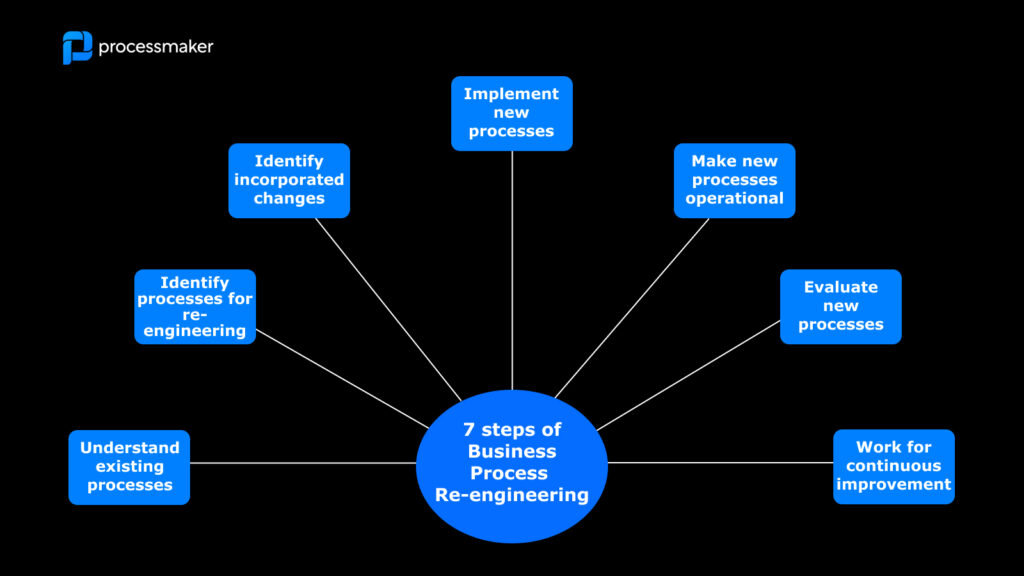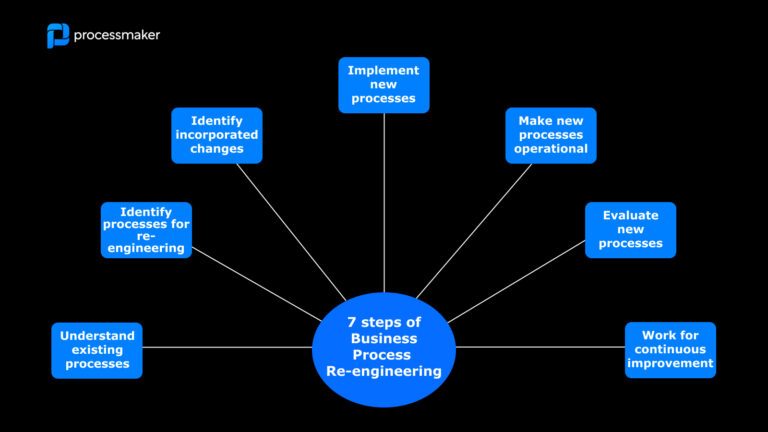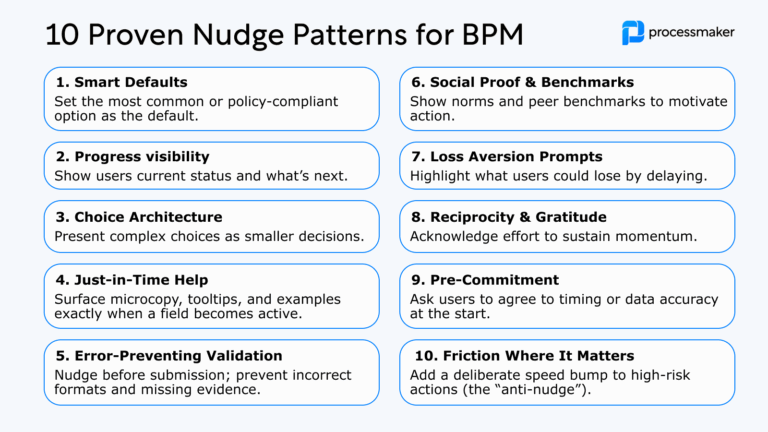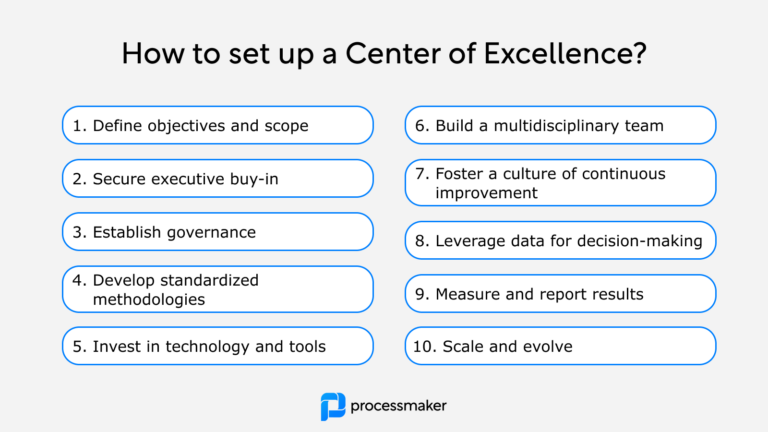Many businesses utilize process analysis as a key method for understanding and improving business processes. While analysis is straightforward, the value added in effective business process management comes from successful execution. In this article, we will explore the key steps and practices for successful process implementation.
What exactly is process implementation?
Business process implementation is the time to put your improved or re-engineered process into practice. Implementation is an ongoing task that requires careful planning and enough time to ensure process actors are well-trained, informed, and happy with the proposed changes.
Implementing new processes can bring numerous benefits to a business. By streamlining workflows, businesses can optimize resource allocation and reduce unnecessary steps. Implementing improved processes promotes efficiency by eliminating bottlenecks and reducing manual work, helping to reduce mistakes and improving the quality of outputs. Finally, new processes can support business growth by enabling scalability and adaptability to changing market demands.

Process implementation is a key step of process reengineering
Process implementation is an integral part of the broader process reengineering effort. It involves redesigning and improving existing processes to achieve significant performance improvements. However, the success of process reengineering depends heavily on the effective implementation of the new processes. The better the reengineering plan and its execution, the smoother the implementation phase will be, especially when combined with the five implementation practices.
What is the process implementation plan?
A process implementation plan is a comprehensive roadmap that outlines the steps and strategies required to successfully introduce and execute new or improved processes within an organization. It serves as a guide for process owners and stakeholders involved in the implementation, ensuring a structured and organized approach.
The plan typically includes key elements such as the goals and objectives of the implementation, the timeline, resource allocation, roles and responsibilities of team members, communication strategies, training requirements, and evaluation measures. The implementation plan provides a clear framework for executing the implementation process, aligning stakeholders, and ensuring that the desired outcomes are achieved. It serves as a valuable tool for project management and helps effectively manage and track progress throughout the implementation journey.
Five key practices for successful process implementation
1. Follow a happy and unhappy path
Understanding the reality and deviations against your desired business process with happy paths helps process owners and teams to see if the new processes are running smoothly. An employee who demonstrates the actions thought up in the reengineering phase, such as easily adopting new technology, buying into the new process, etc., follows the happy path.
However, things seldom flow well during large projects. Spotting an undesired unhappy path helps process owners prepare for the inevitable glitches and deviations they’ll encounter along the way, such as:
- Employees did not receive adequate training on the new system.
- Someone with experience in a particular technology and a specific set of skills must be recruited, and recruitment is time-consuming.
- Employees feel the new process has negatively affected the company culture and team dynamics.
While implementing a new process, remember the 1939 film, The Wizard of Oz. The Yellow Brick Road leads to your desired destination but is filled with things that can push you to the curbside. You must be prepared to react to these challenges to stay on the straight and narrow.
2. Ensure alignment with clear communication and feedback
At the start of the implementation process, top management must agree upon and be aligned with the new vision. To get employees aligned and on board, management must offer a clear explanation of why changes are being made and why they are important. Communicating changes via a series of emails, press releases, or even in-depth video explainers will not be enough to ensure buy-in from all process actors.
When implementing a new process, it’s best to communicate with regular catch-ups, meetings, one-to-ones, and feedback sessions. This is an ongoing project, and employees must be able to ask questions, express concerns and share ideas. Dictating changes can cause upset amongst teams, which threatens to crumble company culture, lower employee satisfaction, and even increase staff turnover rate.
3. Brace yourself for bumps in the road
Resistance to change is common during process implementation. Employees may feel nervous about changes to company culture, job stability, or the introduction of new technology. It is important to recognize that a small healthy amount of resistance is normal and can provide valuable insights. It offers an opportunity to address concerns, make necessary adjustments to the plan, and ensure a smoother implementation. By anticipating and addressing potential roadblocks, businesses can mitigate resistance and increase the chances of successful implementation.
4. Provide adequate training
In theory, a payroll manager is an ideal person to efficiently manage a new payroll system from day one of implementation. In reality, the payroll manager must be allocated enough time and resources to get them onboarded and pay other employees their salaries. Remember, the payroll manager should not have a new working method thrown at them during the implementation stage. Any changes should be agreed upon during the BPR stage.
5. Use process intelligence software
There are lots of implementation software out there, and some will be better suited to your needs than others. However, many teams find implementation easier with process intelligence software that reports progress in real time.
If you’re leading new process implementation projects, it’s typically difficult to get insights into how it really works. Employees whose work is affected by that changing business process still need to deliver the same results for their customers. Because of this, people are busy during the change process and sometimes anxious, trying to gain an objective understanding of what works and what doesn’t.
Offering transparency during the deployment phase, along with easily understood automatic reports and recommendations, helps your team hit the ground running. Seeing the effects of change in real time is crucial for change management.
Employee training and involvement for successful process implementation
Employee buy-in is absolutely essential for successful process implementation. Everyone in the company is directly involved in executing the processes, and their engagement and support are crucial for the changes to be effective. Involving employees in the planning stage, providing clear communication about the reasons for change, and addressing their concerns contribute to a higher level of buy-in and implementation success.
It is important to create an environment where employees feel empowered to provide feedback, ask questions, and share ideas throughout the implementation process. By prioritizing employee training and involvement, businesses can enhance their chances of smooth and successful implementation, ultimately leading to improved performance and outcomes.
Example: Helsinki payroll system update – when small hiccups caused significant issues
Recently, many workers in the city of Helsinki experienced problems with salary payments due to IT errors caused by a payroll system update. The financial department cited errors in the many implementation steps needed to change a system responsible for paying almost 40,000 people.
Several small implementation mistakes resulted in 7,000 unread messages reporting payment problems and workers taking out high-interest loans due to unpaid salaries. One worker was shocked to see a salary of 370,000 euros rather than 3,700 euros in their account. This case showcases how small issues and lack of effective intelligence to monitor implementation can cause, such as:
- Damaged reputations,
- Extra time and money required to fix errors,
- A slower pace of work,
- Frustrated workers and customers,
- The need to issue an official apology,
- The negative implementation experience will likely hurt the chances of getting employee buy-in for future projects,
- Employees might leave after becoming frustrated with dealing with pain points,
- Losing business due to frustrated clients or damaged reputations.
Continuous monitoring and evaluation
Process implementation does not end once the new processes are put into practice. Continuous monitoring and evaluation are essential to measure the effectiveness of the implemented processes and identify areas for improvement. Key performance indicators (KPIs) should be established to track the success of the implementation and assess whether the desired outcomes are being achieved. Regular evaluation allows businesses to make data-driven adjustments, address any issues or challenges that arise, and optimize the processes for better results.
Process implementation is an ongoing activity
Redesigning and implementation are about improving the previous state for better processes, better work, better systems, and better service. However, it is not a simple task and requires careful planning, alignment, and training. By following the outlined steps and best practices, businesses can increase the chances of successful process implementation.
Clear communication, ongoing feedback, and adequate training are key elements in gaining employee buy-in and ensuring a smooth transition. Additionally, leveraging process intelligence software provides valuable insights and enables effective change management. Diligent monitoring and continuous improvement are essential for maintaining the benefits of the implemented processes.





